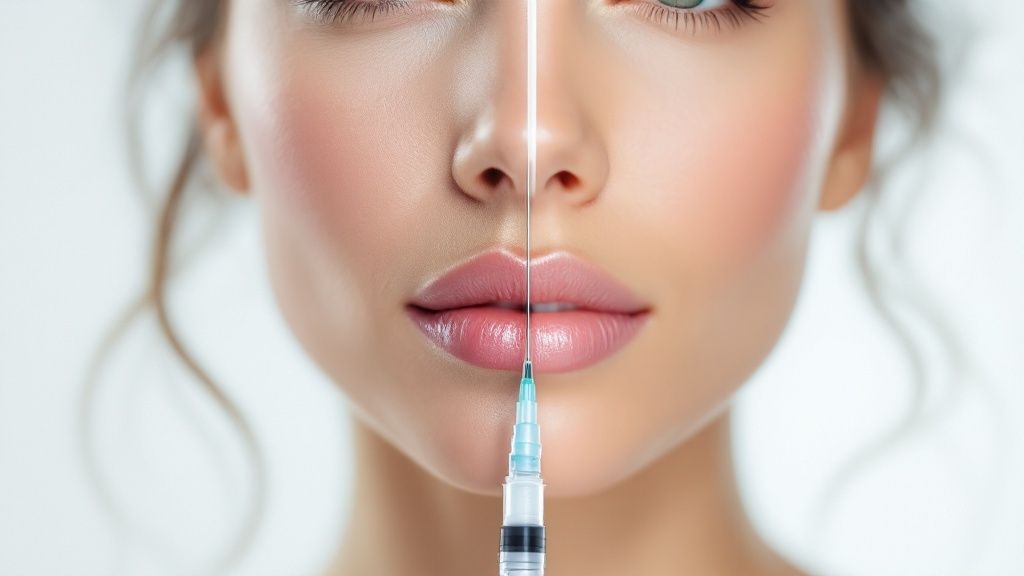
When you're looking for the best filler for smile lines, there's a clear winner in the aesthetics world: Hyaluronic Acid (HA) fillers. Brands like Juvéderm and Restylane are the go-to recommendations from experts because they deliver instant, natural-looking results for nasolabial folds and have an incredible safety record.
Understanding Your Top Filler Options
Smile lines, or nasolabial folds, are a completely natural part of aging, but that doesn't mean you can't soften their appearance. Dermal fillers offer a minimally invasive way to bring back lost volume and smooth out those creases, giving you a refreshed, but not "done," look. The goal isn't to erase every line your expressions have made, but to gently rejuvenate the area for a subtle, beautiful enhancement.
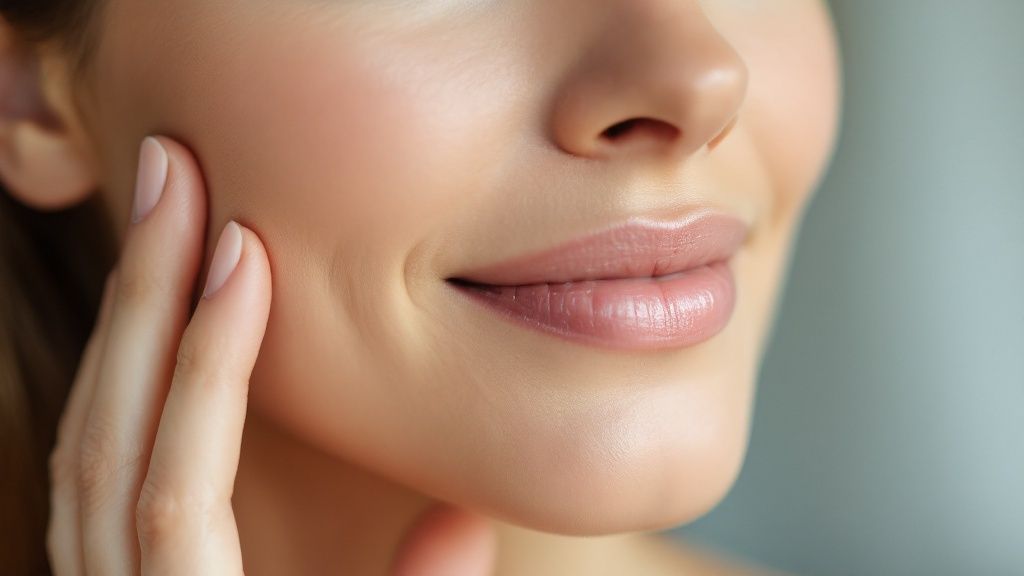
The most popular and trusted solution for this area is, without a doubt, hyaluronic acid fillers. HA is a substance your body already makes, which is why these fillers are so well-tolerated and can even be reversed if needed. Their popularity has fueled massive growth in aesthetics. In fact, the global dermal filler market was valued at around $6.78 billion USD in 2024 and is expected to hit $12.79 billion USD by 2032.
This boom is driven by the proven results and safety of HA fillers, with patients in their 40s making up over 25% of all filler treatments. You can dive deeper into these trends and explore the dermal filler market growth on elitetampa.com.
To give you a better sense of what's out there, here’s a quick rundown of the leading filler types used to treat nasolabial folds.
Top Smile Line Filler Options at a Glance
This table breaks down the most common choices, giving you a clear starting point for a conversation with your provider. Each type has its own strengths depending on your anatomy and goals.
| Filler Type | Primary Component | Average Longevity | Best For |
|---|---|---|---|
| Hyaluronic Acid (HA) | Hyaluronic Acid | 6-18 months | Softening mild to severe lines and restoring immediate volume. |
| Calcium Hydroxylapatite | Calcium Hydroxylapatite | 12-18 months | Correcting deeper folds and providing structural support. |
| Poly-L-lactic Acid | Poly-L-lactic Acid | 2+ years | Gradual, long-term volume replacement by stimulating collagen. |
Ultimately, HA fillers remain the gold standard for their versatility and natural finish, but options like CaHA and PLLA offer unique benefits for specific needs, especially when it comes to deeper folds or longer-lasting results.
So, Why Do We Even Get Smile Lines?
Before diving into the best fillers, it's really helpful to understand why these lines show up in the first place. You’ll often hear them called nasolabial folds, but they aren't just simple wrinkles. They’re actually complex creases created by deeper changes happening under the skin as we age.
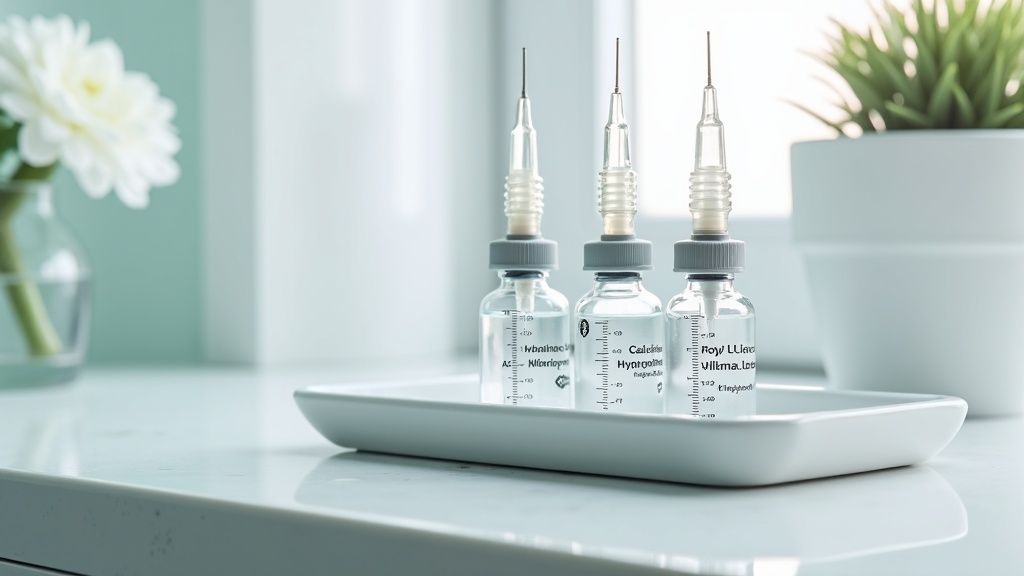
One of the biggest culprits is the natural decline of collagen and elastin. Think of these as the proteins that give your skin its youthful bounce and firmness. As our bodies produce less of them over time, the skin gets thinner and loses its ability to snap back, making it much more prone to creasing from all those years of smiling and making expressions.
It’s Not Just About the Skin—It’s About Volume Loss
But the story goes deeper than the skin's surface. Your facial structure itself is changing. The little pads of fat in your cheeks that create that plump, youthful contour naturally start to shrink and slide downwards with age. This shift hollows out the mid-face and causes the skin above to sag, which is what really carves out that fold running from your nose to the corners of your mouth.
This is exactly why dermal fillers are so incredibly effective for this area. They don't just fill a line; they restore that lost volume, physically lifting the skin and smoothing out the crease for a look that's refreshed, not "done."
Understanding this volume loss is crucial. Fillers don't just "fill a line"; they restore the underlying support structure that has diminished over the years, leading to a much more natural and effective result.
Supporting Your Skin’s Foundation at Home
While fillers work wonders for structural support, keeping your skin healthy is key to making those results last and look their best. To complement your professional treatments, think about adding an at-home device like the BARB N.P. LED Facial Mask.
This mask is comfortable, wireless, and makes daily treatments feel like a breeze. It comes with three light settings to tackle different skin concerns:
- Red Light: Helps kickstart collagen production, which is essential for skin firmness.
- Blue Light: A great option for targeting blemish-causing bacteria to keep skin clear.
- Amber Light: Works to rejuvenate the skin for a healthier, more radiant glow.
Integrating a tool like this into your routine is a smart way to support your skin's foundational health, beautifully enhancing the results you get from your filler treatments.
Comparing the Top Fillers for Nasolabial Folds
When you start looking into the best filler for smile lines, three names pop up everywhere: Juvéderm, Restylane, and Sculptra. It’s easy to assume they’re all the same, but that’s a common mistake. While Juvéderm and Restylane are both made from hyaluronic acid (HA), they behave very differently in the skin. And Sculptra? It's in a league of its own.
Each of these products has a unique way of interacting with your facial tissues to get the job done. Understanding how they work is the key to finding the one that’s right for your face and your goals.
Juvederm: A Soft Touch for Smoothing
Juvéderm is known for its incredibly smooth, cohesive gel. Think of it like honey—it flows seamlessly to fill a space without creating lumps or sharp edges. This makes it a fantastic choice for moderate smile lines where you want a soft, natural look that blends right in with the surrounding tissue.
Because of this quality, a product like Juvéderm Vollure is often my go-to for dynamic areas around the mouth. It allows you to smile and express yourself naturally without feeling stiff or "done." If you're just starting to notice lines and want a subtle softening, Juvéderm is an excellent starting point.
Juvéderm's smooth gel is perfect for filling in those moderate lines and achieving a soft, natural result. It integrates beautifully, making it ideal for anyone who wants subtle yet noticeable rejuvenation.
Restylane: Structural Support for Deeper Folds
On the other hand, Restylane has a firmer, more granular gel texture. This gives it more lifting power, which is exactly what’s needed for deeper nasolabial folds that require real structural support. It’s designed to hold its shape, providing a noticeable lift to the skin that contributes to smile lines.
If Juvéderm is like honey, Restylane is more like a thick gel that can be molded and sculpted. This makes formulas like Restylane Defyne ideal for rebuilding the underlying structure where volume loss is more significant. It’s less about just filling a line and more about propping up the tissue from beneath. While both are HA fillers, they serve very different purposes from muscle relaxers like Botox. You can explore the difference between Juvederm and Botox in our detailed guide.
With its firmer structure, Restylane delivers robust support, making it the right choice for lifting and correcting deeper folds. It acts almost like a scaffold under the skin, precisely rebuilding lost volume.
Sculptra: The Gradual Collagen Builder
Sculptra is the outlier here because it isn't a traditional "filler" in the same way. Its main ingredient is Poly-L-lactic Acid (PLLA), a biocompatible substance that kickstarts your body's own collagen production. Instead of adding volume instantly, Sculptra works behind the scenes over several months to restore your skin's inner structure from the ground up.
The treatment usually involves a series of sessions, but the results are incredibly natural-looking and can last for two years or more. It’s the ultimate choice for patients with more significant, widespread volume loss who prefer a gradual, long-term improvement over an immediate fix.
The chart below gives you a quick visual on how these fillers stack up in terms of duration, cost, and how quickly you’ll see results.
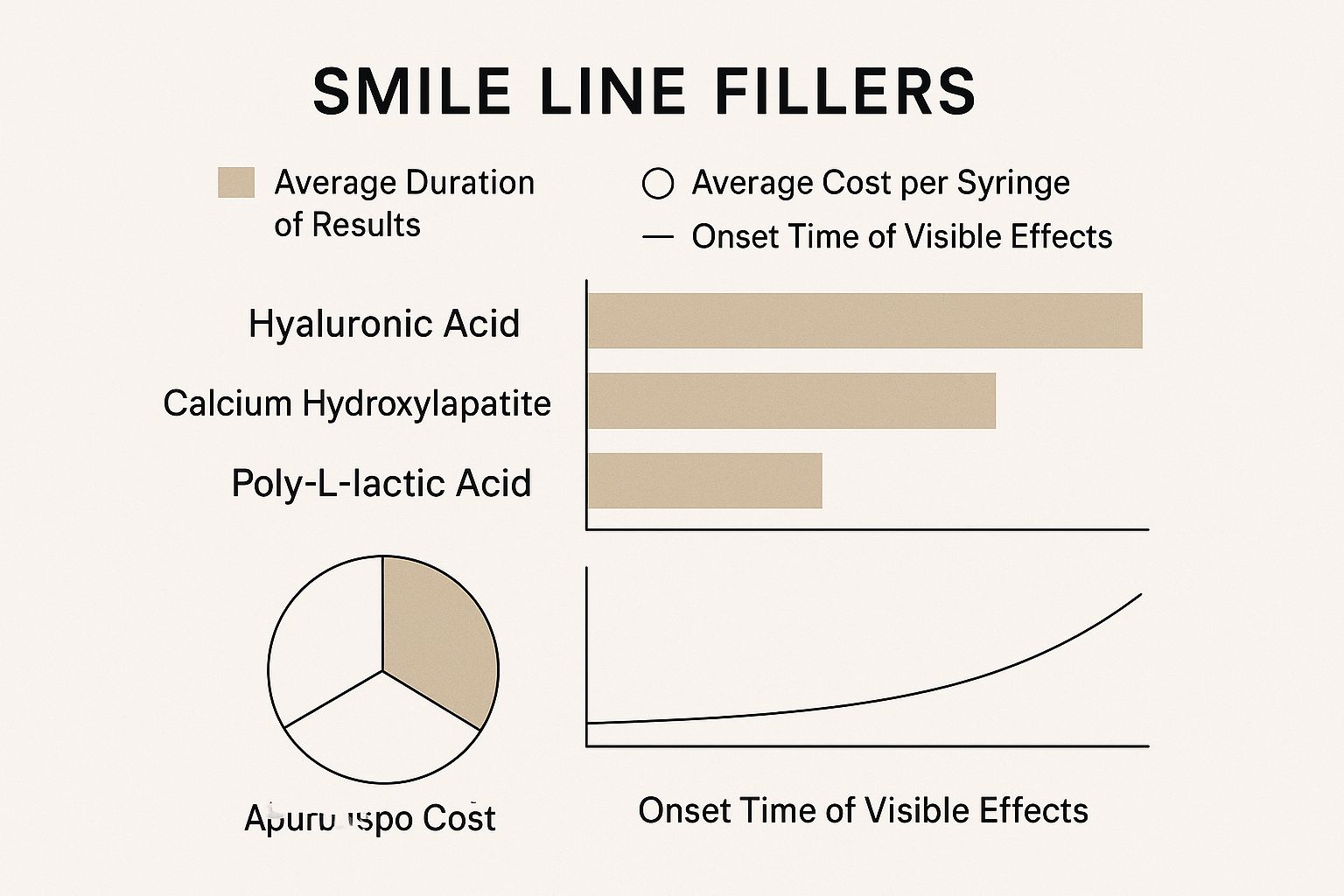
As you can see, HA fillers like Juvéderm and Restylane deliver faster results, but collagen stimulators like Sculptra offer the longest-lasting effects by far.
From a clinical standpoint, hyaluronic acid fillers are still the gold standard for treating smile lines because they're effective, biocompatible, and reversible. You can typically expect results to last anywhere from 6 to 18 months, depending on the specific product and where it’s placed. Clinical studies show that around 70-80% of patients are satisfied with their improvement after just one treatment.
Head-to-Head Feature Comparison
To make the decision a little easier, I’ve broken down the key differences between these top three options in a simple table.
Juvederm vs Restylane vs Sculptra for Smile Lines
This table gives a side-by-side look at the leading dermal fillers used for treating nasolabial folds, helping you understand their core differences at a glance.
| Feature | Juvederm (e.g., Vollure) | Restylane (e.g., Defyne) | Sculptra |
|---|---|---|---|
| Primary Component | Hyaluronic Acid (HA) | Hyaluronic Acid (HA) | Poly-L-lactic Acid (PLLA) |
| Mechanism of Action | Instantly adds volume | Instantly adds volume and lift | Stimulates collagen |
| Onset of Results | Immediate | Immediate | Gradual (2-3 months) |
| Gel Consistency | Smooth, cohesive gel | Firmer, granular gel | Liquid suspension |
| Ideal For | Moderate lines, soft fill | Deeper folds, structural lift | Widespread volume loss |
| Longevity | Up to 18 months | Up to 12 months | 2+ years |
Ultimately, the "best" filler truly depends on your unique anatomy, how deep your smile lines are, and what you want to achieve. A soft filler like Juvéderm is perfect for early lines, while a structural one like Restylane is better suited for deeper creases. For anyone looking for long-term, natural-looking volume restoration, Sculptra is in a class of its own.
Which Smile Line Filler Is Right for You?
Picking the best filler for smile lines isn't about choosing the most popular brand name. It’s about matching the right product to your unique facial anatomy, skin quality, and aesthetic goals. Technical details like gel consistency and composition translate into very different real-world results, and understanding why a provider recommends a certain filler is key.
To help you visualize this, let’s walk through a few common patient scenarios.
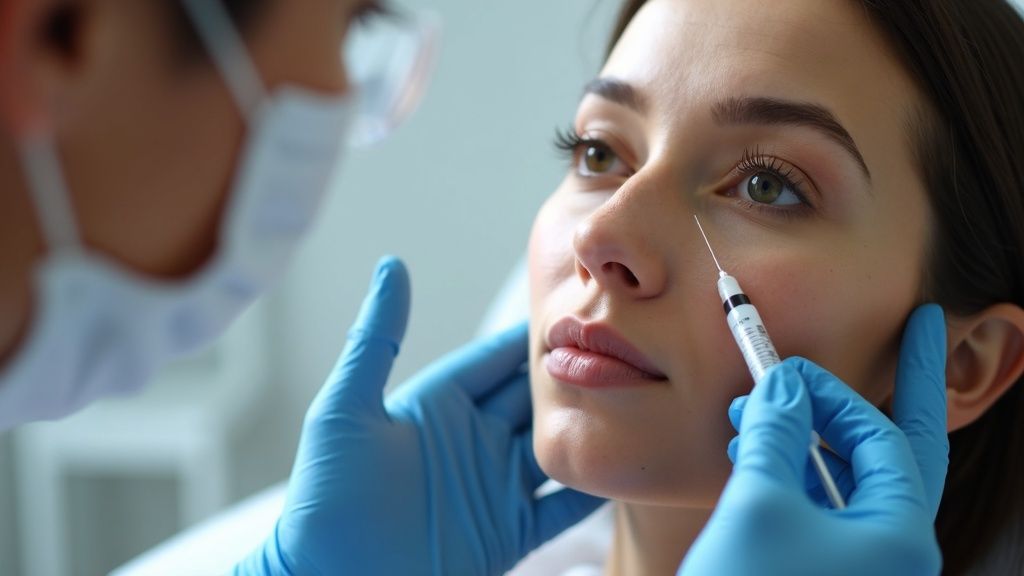
This approach moves beyond generic advice and gives you a peek into the clinical reasoning behind a recommendation. By seeing which profile you identify with, you can start to understand which treatment path might deliver the beautiful, natural results you’re looking for.
Scenario One: The 30-Something with Early, Fine Smile Lines
Imagine a patient in her early 30s who is just starting to notice soft, shallow nasolabial folds. These lines are mostly visible when she smiles and haven’t yet become deeply etched into the skin. Her primary goal is prevention and subtle correction, not adding significant volume.
- Ideal Filler: A softer, more flexible hyaluronic acid (HA) filler like Juvéderm Vollure.
- Clinical Reasoning: For these early-stage lines, the goal is to provide a gentle, seamless fill without adding bulk or looking "done." A smooth, cohesive gel integrates beautifully into the skin, softening the crease while allowing for completely natural facial expressions. The filler acts like a subtle cushion, preventing the line from deepening over time. A heavier, more structural filler would be total overkill here and could look unnatural.
Scenario Two: The 50-Something with Deep Folds and Volume Loss
Now, let’s consider a patient in her 50s with more pronounced nasolabial folds. These are often caused by significant volume loss in the mid-face. As the cheeks start to descend, they create a heavier fold that contributes to a tired or sad appearance. Simply filling the line itself won’t address the root cause.
- Ideal Filler: A more structural HA filler like Restylane Defyne or a collagen stimulator like Sculptra.
- Clinical Reasoning: This patient needs more than just a fill—she needs a lift. Restylane Defyne’s firmer consistency allows an injector to place it strategically to act like scaffolding, rebuilding support in the cheek area and lifting the overlying tissue. Alternatively, Sculptra offers a gradual, long-term solution by stimulating the body’s own collagen to restore volume from within. This addresses the foundational issue of volume loss for a far more comprehensive and lasting result.
To get a better understanding of what these fillers are composed of, you can explore our guide on what dermal fillers are made of.
The key takeaway is that the "best" filler is entirely situational. It depends on whether your smile lines require simple softening or structural support to correct underlying volume loss.
By understanding these nuances, you can have a much more productive and informed conversation with your injector. This ensures you choose a treatment that not only smooths your smile lines but also harmonizes with your entire facial structure, delivering the most natural and beautiful outcome possible.
What to Expect During Your Filler Treatment
Deciding to treat your smile lines is a big step, and knowing exactly what happens during and after the appointment can make all the difference. Understanding the entire process—from consultation to recovery—demystifies the experience and helps you feel confident and prepared for a smooth, successful outcome.
The journey always begins with a thorough consultation. Your provider will take the time to assess your facial anatomy, listen to your aesthetic goals, and recommend the best filler for your specific needs. This is your chance to ask every question you have and ensure you feel completely comfortable with the proposed plan.
The Injection Process
Once you have a plan, the treatment itself is surprisingly quick, usually taking just 15-30 minutes.
First, your practitioner will cleanse the treatment area. They may also apply a topical numbing cream to ensure you're as comfortable as possible. On top of that, many modern hyaluronic acid fillers come pre-mixed with lidocaine, a local anesthetic, which further minimizes any discomfort during the injections.
Using an ultra-fine needle, the filler is carefully and precisely injected into specific points along your nasolabial folds. Most people report feeling a slight pinch or a bit of pressure, but the process is generally very well-tolerated. Afterward, your injector will gently massage the area to make sure the product is distributed evenly for a soft, natural-looking result. If you're curious about the science behind this, check out our guide on how dermal fillers work.
The demand for non-invasive procedures like this has completely reshaped the aesthetics industry. The global cosmetic surgery market, which includes injectable fillers, was valued at nearly $57 billion in 2024 and is expected to climb to around $77 billion by 2032. This incredible growth is fueled by people seeking minimally invasive treatments for concerns like smile lines—often one of the first signs of aging they choose to address. You can learn more about the growing cosmetic surgery market on fortunebusinessinsights.com.
Recovery and Aftercare
One of the biggest advantages of filler treatments is the minimal downtime. Most people head right back to their daily routine immediately after their appointment. That said, you can expect a few common and temporary side effects.
The most common things you'll see right after are mild swelling, a little redness, and possibly some minor bruising at the injection sites. This is all completely normal and typically resolves on its own within a few days to a week.
Following the right aftercare steps is essential for getting the best possible results and ensuring a quick recovery. Your provider will give you a specific set of instructions, but they generally include these key points:
- Avoid Strenuous Exercise: Hold off on intense physical activity for the first 24-48 hours. This helps keep swelling and bruising to a minimum.
- Limit Sun and Heat Exposure: Stay out of direct sun, saunas, and hot tubs for a few days after your treatment.
- Skip Alcohol: It’s best to avoid alcohol for at least 24 hours, as it can thin the blood and increase the risk of bruising.
- Sleep on Your Back: For the first night, try sleeping with your head slightly elevated and on your back to help reduce any morning-after swelling.
By following these simple guidelines, you help the filler settle perfectly and allow your skin to heal beautifully, revealing a smoother, more refreshed you.
Keep Your Results Glowing with At-Home Care
Getting the perfect filler for your smile lines is just the first step. Protecting that investment is how you guarantee those beautiful, long-lasting results. Think of it as teamwork: your injector provides the initial correction, but a smart at-home routine is what keeps your skin healthy and prolongs the effects of your treatment.
A consistent skincare regimen is non-negotiable. It maintains the quality of your skin, which beautifully complements the volume and structure your filler provides. By supporting your skin’s own regenerative processes, you help the treated area stay smooth and youthful for as long as possible. This is where targeted at-home treatments become your secret weapon.
Elevate Your Routine with Advanced Technology
To truly take your at-home care to the next level, think beyond topical creams. Advanced devices can support your skin's health from the inside out. While your daily serums are essential, technologies like LED light therapy offer a deeper rejuvenation that perfectly complements professional filler treatments.
A fantastic, easy-to-use option is the BARB N.P. LED Facial Mask. This device was thoughtfully designed for consistency and convenience. Its comfortable, wireless design means you can enjoy a quick session without being stuck near an outlet, making it incredibly simple to fit into any schedule.
Integrating an at-home device like an LED mask is a proactive way to support your skin’s collagen framework. This helps maintain the smooth, beautiful results you achieved with your filler treatment.
The mask comes with three distinct light settings, allowing you to customize your treatment based on what your skin needs on any given day. That versatility makes it a powerful tool for overall skin wellness.
The three targeted settings include:
- Red Light Therapy: This is your collagen-boosting setting. It's designed to stimulate your skin's natural production of collagen, which is absolutely essential for maintaining firmness and elasticity. Supporting collagen is key to helping your filler results look their best for longer.
- Blue Light Therapy: Ideal if you're prone to blemishes. This light targets the bacteria that can lead to breakouts, promoting a clearer, healthier complexion overall.
- Amber Light Therapy: This setting focuses on rejuvenation. It works to reduce redness and promote a more even, radiant skin tone, giving you that healthy glow.
By incorporating a high-quality device like the BARB N.P. LED Facial Mask into your weekly routine, you’re not just passively waiting for your next filler appointment. You're actively participating in your skin's health, helping to preserve the integrity and appearance of your results. This proactive approach ensures your skin remains a healthy, vibrant canvas for the beautiful, natural-looking correction your filler provides.
Your Smile Line Filler Questions, Answered
Deciding to get fillers is a big step, and it’s natural to have questions. Getting clear, honest answers is the key to feeling confident and excited about your treatment. Let's walk through some of the most common things people ask about nasolabial fold fillers.
How Much Does Filler for Smile Lines Typically Cost?
The investment for treating smile lines with filler can vary, but most people can expect to spend between $700 and $1,200 per syringe. What determines that final number? It comes down to a few things: the type of filler we choose (Juvéderm and Sculptra have different price points), how much we need to get your desired look, and the expertise of your injector.
Remember, you’re not just paying for a product. You’re investing in the skill, artistry, and safety protocols of a medical professional who understands facial anatomy inside and out.
Is Getting Filler for Smile Lines Painful?
Most of my clients find the treatment very easy to tolerate. To make sure you're comfortable, we always start by applying a strong topical numbing cream to the area. On top of that, many of the best hyaluronic acid fillers, like Juvéderm and Restylane, come premixed with lidocaine—a local anesthetic that works from the inside out as soon as the injection begins. You might feel a little pinch or a bit of pressure, but real pain is rare.
What Are the Potential Risks and Side Effects?
When administered by a trained and licensed professional, dermal fillers have an excellent safety record. Like any medical treatment, though, there are potential side effects. The most common ones are mild, temporary, and totally normal:
- A bit of swelling right at the injection site
- Some redness or tenderness for a day or two
- Minor bruising, which can happen even with the best technique
- A feeling of lumpiness or firmness that settles down with gentle massage
Serious risks are very rare but include things like infection, an allergic reaction, or a vascular occlusion (when filler accidentally enters a blood vessel). This is exactly why choosing a highly qualified, experienced injector is so important—it’s the best way to minimize those risks.
How Can I Find a Qualified Injector for My Treatment?
This is the single most important decision you'll make. Start your search by looking for medical professionals with the right credentials—a Nurse Practitioner (N.P.), Registered Nurse (R.N.), Physician Assistant (P.A.), or a board-certified dermatologist or plastic surgeon. You want someone who lives and breathes facial aesthetics and has deep experience with the specific fillers used for smile lines.
Don't be shy about asking to see before-and-after photos of their actual clients. When you go in for a consultation, pay attention to how they listen. A great injector won’t give you a cookie-cutter solution; they'll assess your unique facial structure, listen to your goals, and design a plan that’s just for you.
At Barb N.P., we believe in empowering you with expert knowledge and personalized care to achieve beautiful, natural-looking results. To begin your journey toward a refreshed appearance or to explore our curated selection of medical-grade skincare, visit us online.

